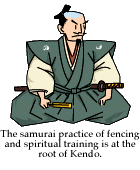 |
HISTORY
Find out how the art form developed and what makes it unique. |
|||||
| History of Kendo | ||||||
|
Kendo, or the “way of the sword,” is similar to forms of fencing seen in other lands. Two contestants wearing armor to protect the face, chest, and arms confront each other with bamboo swords called shinai. There are two theories about the origins of present-day kendo. One has it that the roots of kendo lie in the traditional art of fencing, in which combatants faced off with actual swords. This art, it is said, was brought to Japan from China more than 1,000 years ago. The other theory says that kendo developed from Japan's own brand of fencing. |
||||||
 |
||||||
| Samurai
warriors practiced the art of fencing for a long time, and eventually
practicing with swords became a part of the study of morals and Buddhism,
especially Zen. Samurai eventually had to practice not only fencing but
also spiritual training. Then at the end of the eighteenth century protective
equipment and safe bamboo practice swords were introduced, and the present
form of kendo took shape. Nowadays kendo is very popular in schools as
a sport that provides both physical and mental training.
Kendo has also become a well-known international sport. World kendo championships are held once every three years. Besides Japan, 41 countries participated in the 2000 world championships, including South Korea, Australia, the Netherlands, and Russia. |
||||||
 |
||||||
| The Onuma Wakamatsu Kendo Club, which is introduced in this article, is located in the city of Sagamihara, Kanagawa Prefecture, about 40 kilometers west of Tokyo. Kendo is one of many sports that are popular in this community. | ||||||
| Photo: Sagamiohno Station, near the Ohnuma Wakamatsu Kendo Hall. |